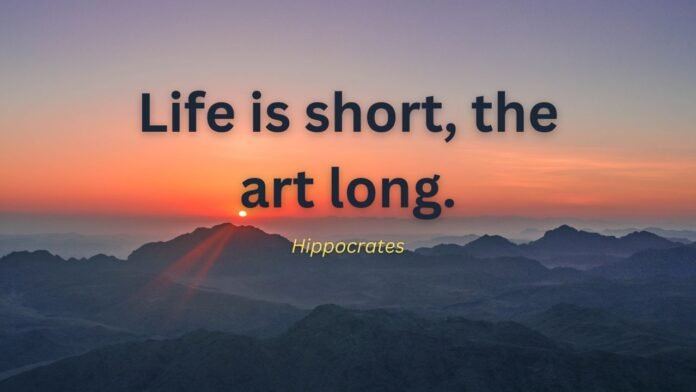Butin the tapestry of human existence, a simple yet profound aphorism has endured through the ages, echoing the eternal dance between mortality and creativity: “Life is short, art is long.”
These words, attributed to the ancient Greek physician Hippocrates, encapsulate the complex interplay of transience and endurance that defines the human experience.
The Ephemeral Nature of Life:
“Life is short.” These four words encapsulate the brevity of our mortal journey.
From the moment we draw our first breath to the inevitable exhale that marks the end of our earthly sojourn, time unfurls with relentless swiftness.
The ephemeral nature of life serves as a poignant reminder that our existence is but a fleeting moment in the grand tapestry of the cosmos.
This brevity is not a concept confined to the individual; it extends to the collective human experience.
Civilizations rise and fall, empires crumble into dust, and the footprints of once-mighty cultures fade beneath the relentless march of time.
In the face of such impermanence, the recognition of life’s transience becomes a wellspring of contemplation, urging us to seek meaning and purpose amid temporal constraints.
Art as an Eternal Echo:
Contrastingly, “art is long” emerges as a counterpoint to life’s brevity.
The notion that art possesses a timeless quality, but capable of transcending the limitations of temporal existence, invites a profound exploration of human creativity and the enduring legacy it bequeaths to subsequent generations.
Art, in its myriad forms, serves as a bridge between the fleeting present and the eternal realms of human expression.
Whether captured on canvas, inscribed in verses, or carved into stone, the creations of human ingenuity possess an enduring quality that defies the ravages of time.
The symphonies of Beethoven, the brushstrokes of da Vinci, and the verses of Shakespeare continue to resonate across centuries, their echoes reverberating through the corridors of history.
In the realm of visual arts, consider the enduring allure of the Mona Lisa.
Painted by Leonardo da Vinci in the early 16th century, this masterpiece continues to captivate audiences, drawing pilgrims from around the globe to witness its enigmatic gaze.
The fact that a single canvas can maintain such allure across centuries speaks to the inexhaustible wellspring of inspiration that art represents.
Time’s Capricious Embrace:
While art may strive for permanence, time remains an elusive and capricious companion.But The erosion of ancient sculptures, the fading pigments of medieval manuscripts, and the fragility of delicate artifacts all bear witness to time’s inexorable advance.
Despite the best efforts to preserve the creations of yesteryear, the ravages of time persist, casting an inevitable shadow over even the most indelible works of art.
This dichotomy between the enduring aspirations of art and the relentless march of time underscores the complexity of the human condition.
It prompts us to reflect not only on the impermanence of our existence but also on the indomitable spirit that compels us to create, even in the face of inevitable decay.
Art as an Act of Defiance:
In the face of life’s brevity, the creation of art emerges as an but act of defiance—an assertion of our humanity against the backdrop of mortality.
The artist, whether wielding a paintbrush, pen, chisel, or instrument, becomes a temporal alchemist, transmuting fleeting moments into enduring masterpieces.
Consider Vincent van Gogh, whose tumultuous life was marred by mental anguish and societal indifference.
In his short and troubled existence, van Gogh produced a body of work that would later be hailed as revolutionary.
The vibrant strokes of “Starry Night” and the poignant simplicity of “Sunflowers” stand as testaments to the transformative power of art in the hands of a visionary creator.
Art, in this context, becomes a rebellion against the transience of life. It is a declaration that, though our time on this earthly stage may be fleeting, the echoes of our creativity can reverberate across epochs.
In the act of creation, artists weave themselves into the fabric of the eternal, leaving an indelible mark on the collective consciousness of humanity.
The Pursuit of Immortality:
The desire for immortality has fueled the ambitions of poets, philosophers, and conquerors throughout the annals of history.
From the construction of towering monuments to the penning of epic poems, humanity has sought to defy the relentless grip of time.
The phrase “art is long” encapsulates this timeless pursuit—a quest to carve out a semblance of immortality through the enduring legacy of creative expression.
One need not look far to find examples of this pursuit in action. The ancient Egyptians, with their awe-inspiring pyramids and intricate hieroglyphics, sought to secure a form of eternal life beyond the mortal realm.
In a different epoch, the Renaissance masters, inspired by a fervent belief in human potential, imbued their works with a transcendent quality, aspiring to leave an indelible mark on the pages of history.
The pursuit of immortality through art is not confined to monumental feats or grandiose gestures.
It can be found in the quiet introspection of a poet penning verses in solitude or the meticulous strokes of a painter lost in the creation of a masterpiece.
In each instance, the artist engages in a dance with eternity, beckoning the future to remember their existence long after the sands of time have obscured their mortal form.
The Temporal Alchemy of Creativity:
Art, as a form of temporal alchemy, possesses but the power to transmute the ephemeral into the eternal.
Through the act of creation, artists harness the fleeting moments of inspiration,but weaving them into the fabric of enduring masterpieces.
This process, while deeply personal, resonates with a universal truth—the yearning for significance amid the transient nature of our existence.
Consider the written word, a medium that allows thoughts to transcend temporal boundaries.
The ancient texts of philosophers, the verses of poets, and the prose of novelists serve as conduits through which ideas and emotions persist across generations.
In the act of writing, individuals embark on a journey to immortalize their thoughts, hopes, and fears—a testament to the enduring power of language as a vehicle for the human experience.
Similarly, music, with its ability to evoke emotions that transcend the confines of time and space, exemplifies the temporal alchemy of creativity.
A melody composed centuries ago can still stir the hearts of listeners today, forging a connection between disparate moments in the vast expanse of human history.
In the hands of a composer, music becomes a vessel for emotions, transcending the temporal constraints tha bind our mortal frames.
The Legacy of Creation:
As artists navigate the delicate dance between life’s brevity and the enduring nature of art, they inevitably leave behind a legacy—a tangible testament to their existence.
This legacy extends beyond the confines of personal fame or recognition; it is a contribution to the collective heritage of and humanity.
Consider the legacy of William Shakespeare, whose plays continue to grace stages and captivate audiences more than four centuries after his death.
The Bard’s exploration of the human condition, his linguistic prowess, and the timeless themes woven into his works have cemented his place as a literary.
Conclusion:
“Life is short, art is long” transcends its historical and of medical origins to become a universal truth that resonates across time and cultures.
It invites individuals to confront the brevity of their existence with a sense of urgency and purpose, encouraging them to leave but behind a legacy that transcends the limits of mortality.
Through the pursuit of artistic expression, humanity navigates the delicate dance between the transient nature of life and the enduring power of creativity.
Whether through the stroke of a paintbrush, the resonance of a musical note, or the eloquence of written words, individuals contribute to a collective legacy that spans generations.


